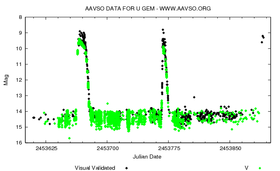- AAVSO light curve of U Geminorum (SS Cygni type)
- Light curve of eclipsing dwarf nova HT Cassiopeiae during outburst, showing eclipses and superhumps (SU Ursae Majoris type)
- Light curve of Z Camelopardalis (Z Camelopardalis type)

A dwarf nova (pl. novae), or U Geminorum variable, is one of several types of cataclysmic variable star, consisting of a close binary star system in which one of the components is a white dwarf that accretes matter from its companion. Dwarf novae are dimmer and repeat more often than "classical" novae. [1]


